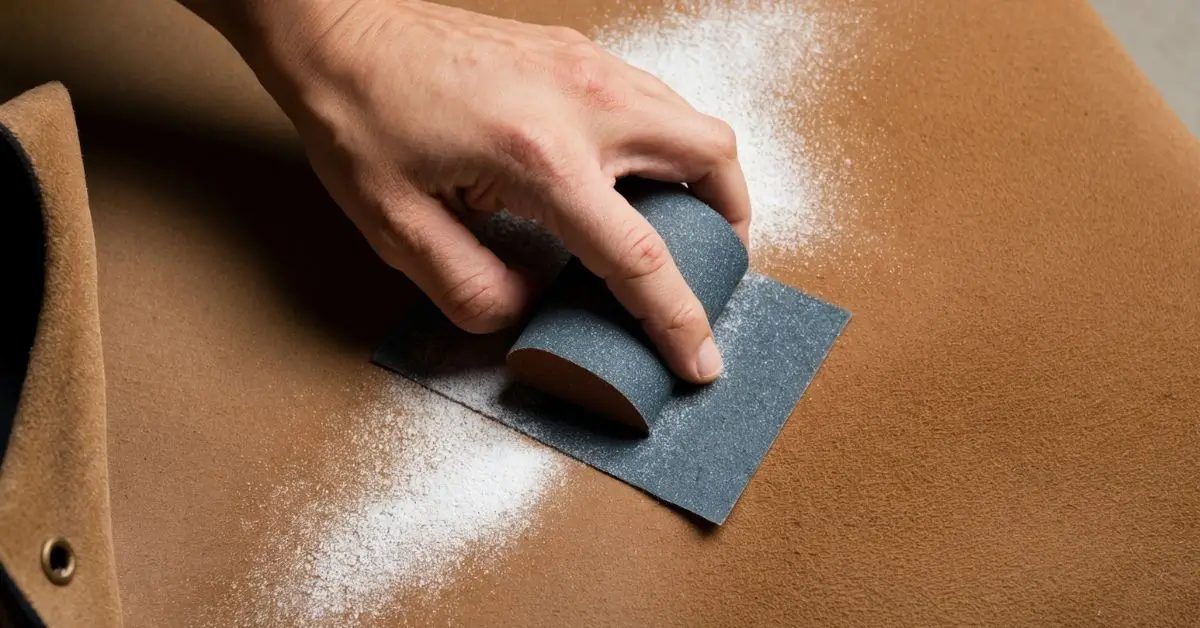Suede is a luxurious material known for its soft texture and velvety finish. It’s commonly used in fashion, footwear, accessories, and furniture. However, suede’s delicate nature makes it susceptible to wear, stains, and other damage, leading many people to wonder if using sandpaper is an effective way to restore its appearance. In this guide, we’ll explore everything you need to know about using sandpaper for suede, including the best types to use, the proper techniques, and alternatives to consider.
Understanding Suede
Before diving into the use of sandpaper, it’s important to understand what suede is and why it’s so delicate. Suede is a type of leather made from the underside of an animal’s skin, typically that of cows, goats, or lambs. Its unique texture comes from its napped finish, which is achieved by buffing or sanding the leather’s flesh side. Suede is softer and more pliable than regular leather but also more prone to damage, staining, and fading.
Suede can easily become scuffed or dirty, particularly on shoes or furniture that are exposed to regular use. While various cleaning techniques are available, using sandpaper is a somewhat unconventional approach but can be effective when done correctly. Let’s examine the role sandpaper can play in maintaining or restoring suede items.
Why Use Sandpaper on Suede?
The idea of using sandpaper on suede might seem counterintuitive, but in certain situations, it can be an effective method for cleaning and restoring the material. Sandpaper is particularly useful for removing stubborn stains, scuffs, and areas where the suede has become matted or shiny.
Common Issues with Suede that Sandpaper Can Address
- Scuffs and Scratches: Over time, suede shoes, jackets, and furniture can become scuffed, especially in high-use areas. Sandpaper can gently buff away these imperfections, restoring the material’s soft texture.
- Stubborn Stains: While suede cleaning brushes are typically used to clean suede, some stains may be too ingrained for a brush to remove. Sandpaper can be a more aggressive option for tackling deep-set stains.
- Flattened or Shiny Areas: Suede can develop shiny spots where the fibers have become compressed. Lightly sanding these areas can help to lift the fibers back up, restoring the nap to its original condition.
- Polishing Damage: In some cases, suede items can suffer from over-polishing, where the natural texture has been worn down. Sandpaper can carefully remove the damaged surface layer and restore the original look.
Choosing the Right Sandpaper for Suede
When it comes to choosing the right sandpaper for suede, not all types are suitable. Sandpaper comes in various grit levels, which refer to the coarseness of the abrasive surface. For suede, you’ll need a very fine grit sandpaper to ensure you don’t damage the delicate material.
Sandpaper Grit Levels Explained
Sandpaper is graded based on the size of the abrasive particles on its surface. The grit levels are categorized as follows:
- Coarse (40-60 grit): This is very rough and should not be used on suede under any circumstances. It is designed for heavy-duty sanding and could destroy the suede fibers.
- Medium (80-120 grit): This is still too rough for suede. While it can be used on some leathers, it is not appropriate for delicate materials like suede.
- Fine (150-220 grit): Fine sandpaper is more suitable for suede. This level can be used for light buffing and removing small imperfections, but it still requires a gentle hand.
- Very Fine (240-400 grit): This is the most appropriate grit for use on suede. It’s gentle enough to remove scuffs and dirt without damaging the suede fibers. This grit range is perfect for buffing and restoring the nap.
- Ultra Fine (500-800 grit): Ultra fine sandpaper is sometimes used for finishing suede items, especially after using slightly coarser grits. It helps to refine the texture and leave the suede looking smooth and even.
Best Sandpaper Types for Suede
Now that you know the grit levels, let’s look at some of the best types of sandpaper to use on suede:
- Aluminum Oxide Sandpaper: This is a popular and versatile type of sandpaper that is relatively gentle. It’s often used for polishing and finishing wood, but the finer grits (above 240) can be used for suede as well.
- Silicon Carbide Sandpaper: Known for its durability, silicon carbide sandpaper is excellent for use on delicate materials like suede. It’s highly effective for precision sanding and polishing. Choose grits in the 400-600 range for the best results on suede.
- Garnet Sandpaper: Garnet sandpaper has a softer abrasive surface, making it suitable for polishing suede. The finer grit versions (240-400 grit) are perfect for this material as they wear away gently without causing damage.
- Wet/Dry Sandpaper: This type of sandpaper is designed for use with water or other lubricants, which can help prevent damage to delicate surfaces like suede. Wet sanding reduces the risk of frictional heat, which could damage the suede’s texture.
What to Avoid
Avoid using sandpapers designed for metalwork, heavy sanding, or extremely coarse sandpapers (below 150 grit) as they can irreversibly damage the suede. Steer clear of power sanding tools as well since they can be too harsh for suede and make it more difficult to control the amount of abrasion applied.
How to Sand Suede: Step-by-Step Guide
Once you have the right sandpaper, it’s crucial to use the proper technique to ensure the best results without causing damage to the material. Here’s a step-by-step guide on how to sand suede safely and effectively:
Materials Needed:
- Very fine grit sandpaper (240-400 grit)
- A suede cleaning brush
- A clean, dry cloth
- Optional: A suede protector spray
Step 1: Clean the Surface
Before using sandpaper, you’ll want to clean the suede as much as possible to remove surface dirt and grime. Use a suede brush to gently remove loose debris from the material. If your suede item is stained, try to address the stain first with a suede cleaner before resorting to sandpaper.
Step 2: Test on an Inconspicuous Area
It’s always a good idea to test your sandpaper on a small, hidden area of the suede item to ensure it won’t cause damage. This will give you a chance to see how the material reacts before you work on the more visible sections.
Step 3: Gently Sand the Suede
Once you’re ready, use very fine sandpaper (240-400 grit) to gently buff the suede in small, circular motions. Don’t press too hard, as suede is delicate, and too much pressure can result in scratches or damage to the nap. Focus on areas that are scuffed, stained, or shiny. Keep the sandpaper moving to avoid over-sanding any one area.
Step 4: Wipe Away Residue
After sanding, use a clean cloth to gently wipe away any dust or residue that may have come off the suede during the process. This step will help ensure that the material is smooth and free of debris.
Step 5: Restore the Nap
Use a suede brush to restore the nap of the suede. Brushing in one direction can help realign the fibers and leave the suede looking even and soft. If necessary, you can use a second, finer sandpaper to lightly polish the surface once more.
Step 6: Apply Suede Protector (Optional)
To protect your suede item from future scuffs and stains, you can apply a suede protector spray. This creates a barrier against moisture and dirt, helping to maintain the material’s appearance for longer.
Alternative Tools for Suede Restoration
If you’re hesitant to use sandpaper on suede, several alternative tools and methods can help restore the material without the risk of damaging it. Here are a few other options:
1. Suede Eraser:
A suede eraser is a specialized tool designed to remove scuffs, stains, and shiny spots from suede. It’s much gentler than sandpaper and is often recommended for small imperfections.
2. Suede Brush:
Suede brushes are specifically made to restore the nap and texture of suede. They come in various types, including brass and nylon, and are great for regular maintenance and minor scuff removal.
3. Nail File:
A fine nail file can be used similarly to sandpaper to buff out minor scuffs and shiny spots. It’s particularly useful for smaller areas and light blemishes.
4. Steam Cleaning:
For flattened or shiny areas, you can use steam to relax the fibers and restore the nap. Hold the suede over a pot of boiling water to allow the steam to rise up and soften the material, then brush it with a suede brush.
Final Thoughts
Using sandpaper on suede can be an effective way to remove scuffs, stains, and other imperfections, but it must be done with care. Fine grit sandpaper, particularly in the 240-400 range, is best suited for this delicate material. By following the right techniques and taking precautions, you can restore your suede items to their original beauty without causing damage.
However, it’s always a good idea to start with less aggressive methods like a suede brush or eraser before turning to sandpaper. With the right tools and a gentle touch, your suede can remain soft, luxurious, and looking its best for years to come.











